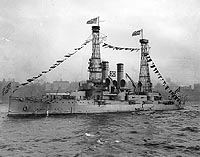USN Ship Types--Mississippi class (Battleships 23 and 24) (original) (raw)
Return to Naval Historical Center home page.  Return to Online Library listing
Return to Online Library listing
DEPARTMENT OF THE NAVY -- NAVAL HISTORICAL CENTER
805 KIDDER BREESE SE -- WASHINGTON NAVY YARD
WASHINGTON DC 20374-5060

Online Library of Selected Images:
-- U.S. NAVY SHIP TYPES -- BATTLESHIPS --
Mississippi Class (Battleships 23 & 24),
1904 Building Program
The Mississippi class represented the U.S. Navy's final design of what would soon be called "pre-dreadnoughts", battleships with a main battery of two or more different-sized guns. Congressional action limited their displacement, a response to the rising size and cost of battleships that was also justified by the hardy theory that numbers of ships are more important that the quality of individual units. Accordingly, they were smaller, slower and shorter-ranged than their contemporaries, though their armament was similar in power: A pair of 12-inch guns in a turret at each end of the superstructure, 8-inch guns mounted in two twin turrets on each side amidships and four 7-inch guns in casemates on each side of the hull. Operationally, the Navy clearly regarded them as inadequate, a view that undoubtedly encouraged their early disposal.
However, during their early careers, _Mississippi_and her sister, USS Idaho, underwent the same pattern of modernization as other modern U.S. Navy battleships. Commissioned right at the end of the era of "white and buff" paint schemes, both received new "cage" mainmasts and were repainted overall gray before the end of their first year's service. In 1910, they were fitted with "cage" foremasts in place of the original "military"type, giving them a much more balanced appearance.
In addition to the usual east coast and Caribbean service pattern of most their contemporaries, both ships made a cruise or two to Europe. Mississippi ended her American career as an aviation support ship, the Navy's first of the type, and tended her seaplanes in a pioneering combat role during the 1914 Vera Cruz operation. In July 1914, the two ships were sold to Greece, the only U.S. Navy battleships ever to be transferred to a foreign power. Nearly three decades later, in April 1941, after their active service had ended, they were sunk by German dive bombing attacks. They were the first American-built battleships to be lost to hostile air attack.
The Mississippi class numbered two ships, both built at the William Cramp & Sons shipyard, Philadelphia, Pennsylvania:
- Mississippi(Battleship # 23). Keel laid in May 1904; launched in September 1905; commissioned in February 1908.
- Idaho (Battleship # 24). Keel laid in May 1904; launched in December 1905; commissioned in April 1908.
Mississippi class "as-built" design characteristics: - Displacement: 13,000 tons
- Dimensions: 382' (length overall); 77' (extreme beam)
- Powerplant: 10,000 horsepower, triple-expansion reciprocating engines, two propellers, 17 knot maximum speed
- Armament (Main Battery): four 12"/45 guns in two twin turrets; eight 8"/45 guns in four twin turrets (four guns per side); eight 7"/45 guns in single casemate mountings (four guns per side)
- Armament (Secondary Battery): Twelve 3"/50 guns in single mountings.
This page features a modest selection of photographs of_Mississippi_ class battleships, plus images related to these ships' basic design features, and provides links to more extensive pictorial coverage of the individual ships.
For coverage of other classes of U.S. Navy battleships, see: Battleships -- Overview and Special Image Selection.
Click on the small photograph to prompt a larger view of the same image.Photo #: 19-N-14910 USS Mississippi (Battleship # 23) "Cleared for action" in 1908, soon after she was completed. Photograph from the Bureau of Ships Collection in the U.S. National Archives.Online Image: 77KB; 740 x 600 pixelsReproductions of this image may also be available through the National Archives photographic reproduction system. 
Photo #: NH 74260 USS Idaho (Battleship # 24) In the Hudson River off Fort Lee, New York, 1909. Photographed by William H. Rau. U.S. Naval Historical Center Photograph.Online Image: 77KB; 740 x 575 pixels 
Photo #: 19-N-62-2-1 USS Idaho (Battleship # 24) Dressed with flags during the Naval Review off New York City, October 1912. Photograph from the Bureau of Ships Collection in the U.S. National Archives.Online Image: 110KB; 740 x 605 pixelsReproductions of this image may also be available through the National Archives photographic reproduction system. 
Photo #: 19-N-60-10-14 USS Mississippi (Battleship # 23) View on the foredeck, looking aft, with the forward 12"/45 gun turret trained to starboard, 1908. Note: anchor chain and capstans; hatches; bridge structure with ship's bell attached below its forward end. Photographed by Enrique Muller. Photograph from the Bureau of Ships Collection in the U.S. National Archives.Online Image: 117KB; 740 x 610 pixelsReproductions of this image may also be available through the National Archives photographic reproduction system. 
Photo #: 80-G-461428 USS Mississippi (Battleship # 23) View on the ship's afterdeck, while she was carrying the Navy's first combat air group to Vera Cruz, Mexico, in April 1914. Planes visible include a Curtiss "AB" type flying boat (on deck at left), and a Curtiss "AH" type floatplane (atop the after 12"/45 gun turret). Note boom rigged to the battleship's superstructure, at left, for hoisting the planes on and off the ship. Official U.S. Navy Photograph, now in the collections of the National Archives.Online Image: 100KB; 740 x 460 pixelsReproductions of this image may also be available through the National Archives photographic reproduction system. 
For more views of Mississippi class battleships, see: - USS Mississippi(Battleship # 23);
- USS Idaho(Battleship # 24).
For coverage of other classes of U.S. Navy battleships, see: Battleships -- Overview and Special Image Selection. Return to Naval Historical Center home page.
Return to Naval Historical Center home page.
Page made 26 March 2001
Minor text correction 7 July 2001